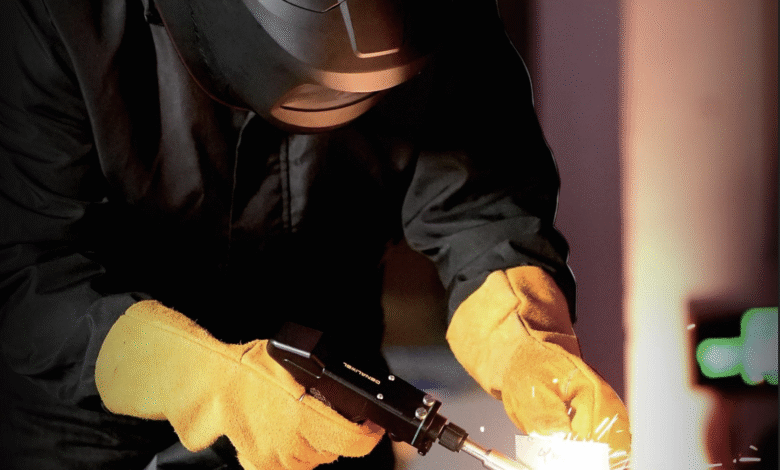Cobot Welders Explained: A Safer, More Efficient Way to Weld

Cobot welding isn’t just another industry buzzword. It’s a real, tangible shift in how welding gets done on the shop floor. Instead of replacing skilled workers, these robots team up with them — taking care of the repetitive, time-consuming stuff while people focus on higher-level tasks.
Let’s break down a few of the standout perks:
- Flexible Operation: Whether you’re switching layouts or tackling different projects, cobot welders adjust without a fuss.
- Built-In Safety: Sensors and smart systems are built in, stopping the machine if someone gets too close.
- Easy to Learn: No complex programming here. Most systems are pretty intuitive — even for folks new to automation.
Bottom line? Cobot welding opens the door to safer workspaces and faster production without overwhelming your team with complexity.
Enhanced Efficiency
Let’s face it — welding can be repetitive. And that repetition? It can wear down even the best welders. Cobot welding steps in to handle the grunt work with precision and consistency.
Here’s what that looks like in action:
- Precision You Can Count On: Say goodbye to the little errors that lead to rework. Cobots are dialed in.
- Faster Turnaround: They move fast — and don’t need a break every few hours.
- Adaptability: Got a change in the job mid-run? Cobots don’t complain. They pivot easily.
Many manufacturers have seen up to a 30% cut in weld times. That means more gets done, with less stress on your crew. It’s not just about speed — it’s about working smarter across the board.
Improved Safety
When it comes to welding, safety’s always been a big deal — and it should be. Hot surfaces, sparks, repetitive motions… it all adds up. Cobot welding helps reduce those risks.
What makes them safer?
- Smart Sensors: These things are sharp — they know when someone’s too close and stop instantly.
- Strict Safety Standards: Most systems follow top-tier safety protocols, so you’re not flying blind.
- Ergonomic by Design: Less awkward bending or holding awkward angles for hours on end.
Here’s what the data says:
| Safety Metric | Reduction |
| Workplace Injuries | 20% |
| Defect Rates | 15% |
| Rework Costs | 25% |
When you factor in fewer injuries, fewer mistakes, and less fatigue, it’s clear cobot welding is doing more than just pulling its weight — it’s making work safer for everyone.
Workforce Empowerment
Let’s set the record straight: cobots aren’t here to steal jobs. In fact, they’re doing the opposite — they’re helping workers do more meaningful, less backbreaking work.
With cobot welding:
- People Upskill: Team members learn to program and manage cobots — a big step up from just running the same welds day in, day out.
- Collaboration Grows: You’ll often find operators working hand-in-hand with machines, not against them.
- Tasks Get Flexible: Cobots can jump from job to job with minimal downtime.
Most companies see about a 30% reduction in training time, which means new hires get up to speed faster, and seasoned workers take on more specialized tasks. It’s a win-win for teams and output alike.
Reliable Integration & Maintenance
Now, if you’re thinking, “Sounds great — but will it work in my current setup?” the answer is probably yes. One of the biggest advantages of cobot welding is how smoothly it fits into existing operations.
Here’s why it’s low-stress:
- Easy Programming: No coding degree required. Most systems are designed for quick learning.
- Smart Sensors: They catch issues before they become big problems — that’s peace of mind built-in.
- Software Keeps Evolving: Regular updates bring new features, better performance, and tighter security.
Even routine maintenance is a breeze — we’re talking a few quick checks each week to keep things running. For most companies, it’s nothing compared to the time saved during production.
Quality Assurance & Real-Time Feedback
There’s nothing more frustrating than discovering a quality issue after a batch has already shipped. Cobot welding helps nip those problems in the bud by keeping an eye on weld quality — in real-time.
Why that matters:
- Spot-On Accuracy: Cobots apply just the right amount of heat at exactly the right speed.
- Consistency Across the Board: No drop in performance after hour five. Or hour ten.
- Built-in Tracking: Each weld is logged. If something’s off, you’ll know — and you’ll know when it happened.
It’s this level of precision and visibility that takes quality control from reactive to proactive.
Strategic and Operational Gains
Denaliweld-powered cobot welding doesn’t just boost output — it gives your whole operation a more strategic edge. Let’s look at some specifics:
- Runs Nonstop: Cobots don’t get tired. They keep going through shifts, weekends — even overnight.
- Quick Changes: Production changes? They’re ready to roll with minimal downtime.
- Tight Tolerances: Need repeatable welds with zero deviation? No problem.
On average, companies that bring cobot welding on board shave about 30% off their welding time. And with safety features baked into the hardware and software, you’re not just working faster — you’re working smarter and safer.
Conclusion
Cobot welding is more than a shiny new gadget — it’s a shift in how we think about manufacturing. Whether you’re looking to ramp up output, improve safety, or just give your team better tools, these collaborative robots offer a seriously compelling solution.
Let’s recap a few key wins:
- Faster Production: 30% time savings is no joke.
- Fewer Injuries: Smart sensors and ergonomic setups drop accident rates by up to 20%.
- Better Welds: Precision and consistency = fewer mistakes.
- Smarter Workforce: Less training time, more value-added work.
- Long-Term Reliability: With the right setup and basic maintenance, cobots just keep going.
At the end of the day, cobot welding is about blending human expertise with robotic efficiency. And if you’re serious about future-proofing your operations, it might just be time to bring a cobot on board.

